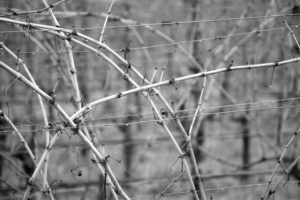
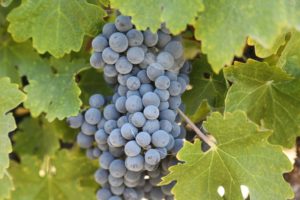
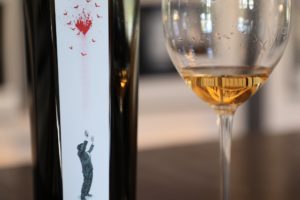 NEOTEMPO Wine was founded by Kia Behnia and Tracy Borman with their inaugural release in 2021. However, the story begins much earlier than this. Kia and Tracy were biking along the Silverado Trail in 1996 when one of their tires went flat. Needing to fix it, they stopped and noticed a nearby property featuring a 1950s era cottage perched on top of a picturesque knoll, a number of older oak trees and surrounding vineyards. Fast forward to 2011; they purchased this same property. Vines were still growing on site at the time of their acquisition; they hired Mark Neal of Neal Vineyard Management to replant the vines, initially all to Cabernet Sauvignon. Three acres of vines on the five acre property were planted in 2012 to three unique clones of Cabernet Sauvignon including 338, 412 and 685, all Foundation Plant Services (FPS) certified.
NEOTEMPO Wine was founded by Kia Behnia and Tracy Borman with their inaugural release in 2021. However, the story begins much earlier than this. Kia and Tracy were biking along the Silverado Trail in 1996 when one of their tires went flat. Needing to fix it, they stopped and noticed a nearby property featuring a 1950s era cottage perched on top of a picturesque knoll, a number of older oak trees and surrounding vineyards. Fast forward to 2011; they purchased this same property. Vines were still growing on site at the time of their acquisition; they hired Mark Neal of Neal Vineyard Management to replant the vines, initially all to Cabernet Sauvignon. Three acres of vines on the five acre property were planted in 2012 to three unique clones of Cabernet Sauvignon including 338, 412 and 685, all Foundation Plant Services (FPS) certified.
One of the questions Kia and Tracy asked themselves when deciding on clonal selections was how to highlight complexity and character from the site while still preserving their terroir. For the first few years they sold grapes to Darioush and Shafer Vineyards; the grapes were being blended into other wines. However, part of their agreement during this period was a small amount of home wine would be produced separately allowing them to evaluate the progression of their vineyard. Small amounts of wine were produced in 2014, 2016 and 2018. They tasted the 2018 vintage with friends, sommeliers and others in the wine industry and were encouraged by supportive feedback.
After they purchased the property, they removed the old cottage and built a new house. It was finished in 2016; the next year the property and the house were threatened by devastating fires burning across Atlas Peak and nearly reaching the Silverado Trail. Tracy was home at the time and was fighting spot fires on the property using numerous fire extinguishers. Those eventually ran out, the intensity of the fire increased and she had to evacuate. While neighbors were not so lucky, the winds changed, their vineyard acted as a fire break and their new home was spared.
This fire and other fires during subsequent years, especially in 2020 changed their way of thinking and they realized that they they needed to focus on sustainability and methods to mitigate their footprint both in terms of farming and packaging. And implement technology, but be creative in how it is used. Those making wine throughout history were producing in the context of their era using whatever tools were at their disposal. As technology has developed, winemaking has certainly utilized its advances. Just look at the improvements in both viticulture and winemaking in the past 50 years. But beyond technology, an integral part of NEOTEMPO’s philosophy is to encourage creativity, nurture curiosity and provide an environment conducive to problem solving.
With Kia’s love of music and their focus on being innovative the name NEOTEMPO ideally describes their philosophy. Neo refers to new and tempo is a musical term referencing the speed at which music is being played. Or in a similar manner, it refers to the rate or speed of motion or an activity. And Kiatra was chosen as the name of their vineyard by combining Kia’s first name with the first three letters of Tracy’s name.
When contacting winemaker Tony Biagi for the first time, Kia remembers receiving a text back from him, “is this Kia from CD Research?”, followed by, “you saved me from Poison” (referring to the heavy-metal band). This obscure reference was in regard to when both Kia and Tony were in college at UC Davis. While studying computer science Kia worked at a music store called CD Research located at 407 G Street; one of the perks of shopping here was customers could request to listen to music from a particular cd before they would buy. Tony would shop there and is where both men originally met.
Kia has admired Tony’s wines for years and his ability to be true to terroir regardless of site. And for Tony it has been a chance to work with unique clones. In working with the Kiatra Vineyard he has been known to say, “I don’t have much work to do” referring to the quality of grapes at the time of harvest and each clone standing out on its own merit.
And rounding out their talented team is Phil Coturri, known for his pioneering work in the field of organic and biodynamic viticulture.
NEOTEMPO is built upon innovation and creativity, from dirt to glass. Both Kia and Tracy made several observations in regard to contemporary Napa Valley winemaking: many of the wines are starting to taste the same and are showing more homogenous rather than unique, individual winemakers are taking on a greater number of clients and many of the most premium wines being produced for brands are being sourced from the same vineyards. They realized that because of climate change and other factors they needed to take a different approach from the beginning. However, an important distinction is they are not trying to be different just to be different, but are trying improve their overall efforts by being different.
The amount of support from the local wine community has been an integral part of their success. Ren Harris, the proprietor of Paradigm Winery has been particularly helpful, especially in regard to viticulture. Vintner Juan Mercado helped introduce them to the right people and their neighbor, Darioush Khaledi (Darioush Winery) has been a mentor.
The Wine
Rosé
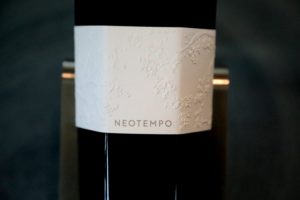
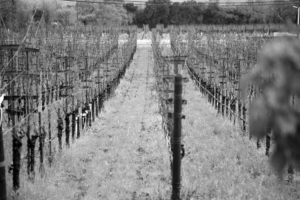 The 2024 Neotempo Rosé Sensoria Love Nick Walker, Grenache Sonoma Valley is 100% varietal. This wine is pale copper in color; the attractive and elegant aromatics include scents of raspberry, strawberry, mandarin orange, white strawberries, white peach, a whisper of guava and lychee. Distinctive on the palate in terms of both its flavor profile and texture and bone dry; this wine tastes like strawberry, raspberry, a light note of watermelon jolly rancher and ruby grapefruit. Nicely balanced, the integration of flavor, texture and acidity makes for a thoroughly enjoyable experience. Lingers fresh and mouth watering with a lightly rounded texture and a light note of anise seed and tarragon, both indicators of the typicity of this variety. The ABV is a refreshing listed 12.7%. This wine is named in homage to grafitti street artist Nick Walker who began his career in the streets of Bristol in the early 1980s. Kia and Tracy a Nick Walker original piece of art called Haunted Love.
The 2024 Neotempo Rosé Sensoria Love Nick Walker, Grenache Sonoma Valley is 100% varietal. This wine is pale copper in color; the attractive and elegant aromatics include scents of raspberry, strawberry, mandarin orange, white strawberries, white peach, a whisper of guava and lychee. Distinctive on the palate in terms of both its flavor profile and texture and bone dry; this wine tastes like strawberry, raspberry, a light note of watermelon jolly rancher and ruby grapefruit. Nicely balanced, the integration of flavor, texture and acidity makes for a thoroughly enjoyable experience. Lingers fresh and mouth watering with a lightly rounded texture and a light note of anise seed and tarragon, both indicators of the typicity of this variety. The ABV is a refreshing listed 12.7%. This wine is named in homage to grafitti street artist Nick Walker who began his career in the streets of Bristol in the early 1980s. Kia and Tracy a Nick Walker original piece of art called Haunted Love.
Cabernet Sauvignon
The 2022 NEOTEMPO Kiatra Vineyard Estate is 100% varietal Cabernet Sauvignon is deep ruby and nearly opaque; the bouquet smells intriguing, dark fruited and savory. These scents include black plum, blackberry, boysenberry, dark mulberry, chalkboard, petrichor, lavender, soy, dark cocoa powder and a light dusting of dried herbs. Ripe but equally as important to note (especially in regards to this ‘hot’ vintage in Napa Valley) is the associated brightness from the lively acidity, especially noticeable on the finish. More red fruited than dark, this wine tastes of red plum, cherry, currant, cranberry and raspberry with a finishing chalky character. The rounded tannins are positioned positively; they fully coat the palate with their lighter to moderate dusty grip. This is a beautiful and balanced expression from a very challenging year. Very food friendly.
The 2021 NEOTEMPO Kiatra Vineyard Estate 100% varietal Cabernet Sauvignon is deep ruby and opaque with an amaranthine rim; getting color has never been a problem from their property. The bouquet is elegant, fresh, dark and layered, with an attractive union of both fruit and barrel influences. Its aromatics include dark plum, blackberry, toasted oak including cedar, olive, dark chocolate and assorted baking spices. There is a freshness that is displayed on both the bouquet and the palate that is simply not present in a wine that is too ripe. This bottling offers an intensity of flavor but with an overall balance. The palate is simultaneously red and dark fruited with flavors of plum and blackberry accompanied by some savory notes including tobacco spice, crushed black and pink peppercorn, an herbal note which shows more as a dried herb character, and a lingering dryness/earthiness on the extended finish. The tannins are rounded and fully coat the palate but in a gentle sort of way. This wine captures both elegance and the complexity of the site but with an overall restraint. This is an impressive inaugural showing which already stands out from the crowd.
Kia and Tracy recommend to open and decant the bottle two hours prior to drinking. 407 cases were produced. This wine was aged for 18 months 80% new French oak barrels. It is 14.2% alcohol.
Each year the winemaking takes into account what occurred in the vineyard and respects vintage variation. Clones are fermented and aged separately. Blending is an important part of their winemaking, evaluating how much of and which clones will be used in the final bottling. For example in 2021 wine from two of their three clones were used. And the wines are aged in a variety of oak from different coopers including various toast levels. Despite such a small vineyard, numerous options are available during their blending sessions.
Both Kia and Tracy are foodies. While waiting for their first vintage to age, combining their love of travel and food, they decided to experiment with how their wine interacted with a diversity of cuisines. While visiting South Africa and Spain they brought barrel samples of their 2021 vintage to a number of restaurants. They took detailed notes at each restaurant with dishes ranging from paella to springbok. This ‘research project’ made them realize the versatility of their wine and helps them communicate recommended pairings with their customers.
They also work with chefs to create out of the box pairings including with James Beard award winning chef, David Cruz.
While the focus of their production is on their estate Cabernet Sauvignon, some of their vines were grafted over to Grenache, Mourvèdre and a tiny amount of Cabernet Franc. Their goal is to produce several bottlings each year using these other components either as blending varieties or as their own varietal wines. And they purchase grapes from other Coturri managed vineyards from Sonoma County.
The Packaging
The eye-catching bottle design is a combination of form and function and is the result of a remarkable amount of time, thought and effort into its creation. Its hexagonal shape from the upper to mid bottle tapers into a traditional round shape at the bottom. The neck of the bottle is also rounded. In a nod to their tech background and successful companies who started in garages, they setup a 3d printer in their garage and printed 42 variations of bottle shapes. Then they met with 14 glass companies and requested their lightest bottles. They were provided samples but ultimately came to conclusion these lightweight and round bottles would be susceptible to breakage during shipping.
Their bottle was in part inspired by the shape of honeycomb produced in bee hives. One of the bottles they tried to emulate in terms of its lightness was a 1987 Grace Family Vineyards estate Cabernet Sauvignon, which wasn’t originally designed with shipping in mind. It weighed 570 grams; the NEOTEMPO bottle beat that weight by 10 grams. Its shape is highly advantageous for shipping both in terms of saving space and its inherent strength based on its hexagonal design. Each bottle has two sides, a narrow side for packing and then a slightly wider side which is used for display. A standard pallet holds 56 cases of wine, with 12 bottles in each case for a total of 672 bottles. Their bottle shape is significantly more efficient for shipping, to the tune of 1,000 bottles per pallet instead of the standard 672.
During the bottle design process they cut pieces from numerous glass bottles, measuring lengths and widths with digital calipers in order to fully understand the minutia of various designs, shapes, sizes and functionality. When looking to improve something so commonly used, design evolutions must be made by taking into account the most minute of details. One of their design features is also a “sommelier cut”, a narrow indentation in the neck of the bottle in conjunction with the location of the bottom of the foil.
They located one glass manufacturing company based in Spain (Estal Glass) who can produce this type of bottle. This company is setup so they create new bottles out of 100% post consumer recycled glass. With recycled glass there is a 40% heat reduction when using the furnace as compared to higher temperature needs for starting with sand as the base material. And because they are using recycled glass, each bottle varies slightly with minor imperfections. The NEOTEMPO bottle was a finalist in the 24th edition of the Formes de Luxe packaging competition held in October 2022 in Monaco.
Once the bottle was designed they needed an appropriate box for shipping. They designed the box themselves out of cardboard making sure that each bottle is snugly secured in its respective holder and never touches each other. The box is made of recyclable material and was designed to be shipped in a horizontal position, good for the wine as the cork always remains moist. The boxes are made in the U.S.
The design of the label was based on the oak trees growing on their property; it was these trees and the views which originally captured their attention. Some of the trees are 180+ years old. They built their home to avoid having to remove any oak trees and when installing the pylons for their foundation they made sure they were not destroying or damaging any of the roots.
Once the wine was bottled, they invited sommeliers to pour their wine. They tested small hands versus larger hands in conjunction with the feel of holding the hexagonal part of the bottle. One of Kia’s pet peeves with heavy glass is that it can be difficult to know when a bottle is empty. They don’t have that problem with their lighter bottles. They also tested inserting the bottles in numerous wine racks, wine refrigerators and other storage spaces. These bottles fit as well as any round bottle.
And they filed four patents in regard to its design.
Kia became highly intrigued while reading an article detailing microscopic photography; he thought to himself what would photographs look like if they were taken of wine on a microscopic level. So he reached out to cell/neurobiology researcher turned professional wildlife photographer Robert Berdan and asked him if he had ever photographed crystals from wine. Berdan had not, and wasn’t sure it could be done but agreed to try. One of the early scientists to study wine crystals was Louis Pasteur who in his research identified two distinctly different crystal types. One of Napa Valley’s noted winery owners, Georges de Latour operated a cream of tartar business prior to founding Beaulieu Vineyard. He would scrape off potassium tartrate crystals from the inside of wine casks following their use in local wineries and processed these for use in baking powder (crème of tartar).
Kia sent Beran samples of wine from each of their three clones. Berdan created crystals using several methods including freezing wine, drying wine (which had the most desired results) and heating wine on a microscope slide. These created tartaric acid crystal sheets which displayed a variety of colors through a polarized light microscope. He was then able to photograph these using Nikon and Canon DSLR cameras.
The resulting photographs are stunning, otherworldly and brilliantly colored reflecting a variety of geometric shapes and sizes including some with a feathery character. A print of one of Berdan’s images is included with every three-pack of NEOTEMPO wines purchased. And each print was taken from crystals from that years’ vintage displaying an image that is typically magnified 50 to 100x from its original size.
This wasn’t the first time microscopic photographs were made of Napa Valley wines. Dr. Sondra Barrett began taking photographs of biological organisms under the microscope in 1977 and in 1983 began to focus more on micro-wine photography. Her photograph of a 1978 bottle of Sterling Vineyards Merlot led to her becoming an artist in residence in the mid 1980s at Sterling Vineyards. Her photography exhibit at Sterling Vineyards in 1984 was titled, A New Look at Wine. She proposed calling this type of photography Molecular Expressionist Art.
Vineyard/Management
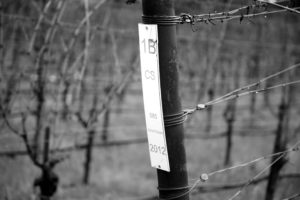 Their organically farmed vineyard is located on the eastern side of the valley at the base of the Vaca mountain range and is situated in the southern part of the valley, a short drive north of the city of Napa. This location is generally cooler than up valley due to its closer proximity to the chilly waters of the San Pablo Bay during the growing season with afternoon cooling breezes a common occurrence. Despite such a small property and only three acres of vines, the site features a variety of exposures and nine different blocks. Cabernet Sauvignon clone 412 is planted in the front of their property on the lower slopes of their knoll down to the valley floor and faces west. Clone 338 and 685 are planted to the rear of their property (on the east side).
Their organically farmed vineyard is located on the eastern side of the valley at the base of the Vaca mountain range and is situated in the southern part of the valley, a short drive north of the city of Napa. This location is generally cooler than up valley due to its closer proximity to the chilly waters of the San Pablo Bay during the growing season with afternoon cooling breezes a common occurrence. Despite such a small property and only three acres of vines, the site features a variety of exposures and nine different blocks. Cabernet Sauvignon clone 412 is planted in the front of their property on the lower slopes of their knoll down to the valley floor and faces west. Clone 338 and 685 are planted to the rear of their property (on the east side).
Each clone offers different characteristics to their wine; for example clone 338 contributes bright acidity and a silky texture. It is also a very late ripening clone and is always the last of the grapes to be harvested from the property. It has earned the nickname, “three three late” for a reason – although they have never had an issue with ripeness with this particular clone. And clone 412 offers more of the structural component and ripe character.
With a background in technology, Kia and Tracy have invested heavily in sensor and data technology to better understand their vineyard including monitoring the irrigation, soil temperature and health of individual vines. Their ‘smart farming’ helped pinpoint individual harvests dates and micro picks, especially in 2021. S.M.A.R.T. refers to vineyards which are: Sustainable, Monitored, Automated, Resilient and Technology Enabled.
In conjunction with U.C. Davis professor Mayson Earles (Viticulture and Enology) and with the assistance of several of his students, Kia and Tracy partnered in a startup software company called Scout focused on using cameras mounted to four-wheelers and AI to evaluate every vine on their property. This software examines the vine health and vigor and assigns each plant a category ranging from strong, medium to weak.
It also evaluates crop yields, can catch diseases before they spread such as red blotch and provides precision in regard to watering and nutrient additions. They discovered they were over watering and depending on the year have been able to reduce their water needs by up to 25%. This data was particularly valuable during the heat spikes in late 2022 in deciding how much water to use, timing of watering and which parts of their vineyard needed the most water. Part of their collection of data involves sharing this data with others managing vineyards; other vineyards have already begun using the software including some of Napa Valley’s most well-known wineries.
In 2025, Scout Gen5 was selected for TIME’s List of the Best Inventions of 2025. For more information, visit: https://agscout.ai
2023 was the first vintage at Neotempo in which the grapes were managed entirely by an electric tractor (Monarch) with all of its power coming from solar cells on the property.
—
Kia and Tracy are clearly enjoying the results of their efforts, both in the vineyard and their wine. And they appreciate sharing their knowledge with others. But perhaps what gives them the most satisfaction is seeing the joy their wine elicits in people, especially when individuals go for an immediate revisit after their first sip.
Tasting Salon, St. Helena
Neotempo opened a speakeasy type space in St. Helena in late 2025. We will visit in November or early December 2025 and will update our notes here.
—
The wines are primarily sold direct to consumer through their allocation list (limited to 6 bottles). However, a limited number of retail spaces in Napa Valley may carry their wines including ACME and Studio 1299a (both in St. Helena), V Wine Cellars in Yountville and several locations near San Francisco. The wine is also locally available at the French Laundry and Oenotri with some very limited distribution in parts of Europe. With the reduced weight of their bottles, NEOTEMPO covers the cost of shipping the wines. For more information and to join the allocation wait list, please visit: https://neotempo.wine






Leave a Reply